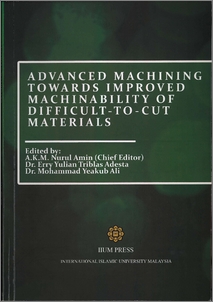Amin, A. K. M. Nurul and Chong , Chee and -, Sayedatul Akma
(2011)
Effects of scribing wheel dimensions on LCD glass cutting.
In:
Advanced Machining Towards Improved Machinability of Difficult-to-Cut Materials.
IIUM Press, Kuala Lumpur, Malaysia, pp. 259-265.
ISBN 9789674181758
![[img]](http://irep.iium.edu.my/style/images/fileicons/application_pdf.png)  Preview |
|
PDF ( Effects of scribing wheel dimensions on LCD glass cutting )
- Published Version
Download (557kB)
| Preview
|
Abstract
Nowadays, LCD is present everywhere in man-machine interfaces. It is used on various kind of
instrument, such as Personal Digital Assistant (PDA), mobile phone, digital clock due to the
superiority of display quality, relatively lower power consumption, small size, low weight, and
also to its dimensional flexibility from less than one inch to as large as forty inch diagonal in flat
television screen currently, Funaki [1]. Glass cutting is one of the important processes in LCD
manufacturing. It has significant impact on the manufacturing yield. In the actual glass cutting
process in LCD manufacturing plant, faulty cutting, which is commonly called “misbreaking”,
always happens. It is a serious problem that reduces LCD production yield. In 1947, Taylor [2]
studied the crack mechanism of glass by point indentation through the making of first Vickers
hardness measurement. He observed some cracks at corners of diagonals impression. Holland
and Turner [3] investigated strength degradation by scratching with worn and new diamond
chips. They found that scratching creates two types of cracks, median and lateral. However, they
did not correlate these cracks to material strength. John and Blair [4] conducted similar
experiments to investigate the influence of interval time between scratching and breaking on
strength. They found that the required breaking load was increased when the interval time was
long Muir [5] explained that there are 28 parameters in the scribing process that need to be
considered in meeting the quality requirement of glass cutting. Laser splitting of glass has been
demonstrated to be effective and economical. Swain [6] discovered that laser splitting of glass
necessitates the development of a sub-microscopic crack within the body of the glass by
controlling the generation of stress. Veldkamp et al [7] observed cracking during the scratching
of several brittle materials including glass. They reported the creation of several types of cracks
such as median crack, lateral crack and surface cracks as a function of scratching load or speed.
This present work focus on the study of the crack creation and propagation mechanism when
apply scribe/break method on ITO coated soda lime glass using Tungsten Carbide scribing
wheel. Focus is put at improvement of LCD glass cutting quality and its economic value.
Actions (login required)
 |
View Item |


 Download Statistics
Download Statistics Download Statistics
Download Statistics